The Control and Prevention of HIV/AIDS in Malaysia
Meer Ahmad AM1*
1 Meer Ahmad Health Consultancy, A317 Apt Selasih, Jln PJU 10/1C, Damansara Damai, 47380 Petaling Jay, Selangor, Malaysia & Innotech Resources, Kelana Jay, 47301 Petaling Jay, Selangor, Malaysia & Innotech Resources, Kelana Jay, 47301 Petaling Jay, Selangor.
*Corresponding Author: Meer Ahmad AM, Meer Ahmad Health Consultancy, A317 Apt Selasih, Jln PJU 10/1C, Damansara Damai, 47380 Petaling Jay, Selangor, Malaysia, TEL: +603 6419 5166; FAX: +603 6419 5166; E-mail:meerahmadmeera@gmail.com
Citation: Meer Ahmad AM (2019) The Control and Prevention of HIV/AIDS in Malaysia. Allergy drugs clin immunol 3:115.
Copyright:© 2019 Meer Ahmad AM, et al. This is an open-access article distributed under the terms of the Creative Commons Attribution License, which permits unrestricted use, distribution, and reproduction in any medium, provided the original author and source are credited.
Received date: August 23, 2019; Accepted date: September 15, 2019; Published date: September 18, 2019.
Abstract
Introduction: Malaysia is fighting the Control of the HIV-epidemic the Prevention starting with the first-case in 1985 and from the time the National Task Force became established just prior to that – and, has seen some success. Strong political-support, workable-policies, undivided-participation and perseverance is found the mainstay.
Aim: The Aim of this Article is to describe the Epidemiology and Disease-burden of HIV/AIDS in Malaysia in a literature-review along with the process of planning, policy-making, implementation, financing and evaluation of Control and Prevention programs in Malaysia from the start, beside the constraint.
Results: By 2015, Malaysia had successfully reduced new-infection by around 50% from 2000. Every major milestone in the country’s response to HIV/AIDS, and the corresponding infection-rate are noted. People who inject drugs (PWID), female sex-worker (FSW), transgender-people (TG) and men who have sex with men (MSM) represent the country’s most affected by the epidemic. There is an estimated 92,895 people living with HIV (PLHIV) at the end of 2015.
New HIV-infection has declined by 50%, while the number of HIV/AIDS-related death has stabilized. Availability and accessibility of antiretroviral has been improved from the time that became a component of care, treatment and prevention in 1990. The pattern has moved from mainly PWID to increasingly sexual-transmission. The National Strategic Plan (NSP 2010 – 2015) addresses the vulnerable and at-risk populations, co-infections, financing, and psycho-social factors. The Burden of the Disease in Malaysia is noted here beside the financial-cost of the HIV/AIDS in Malaysia.
Conclusions: Malaysia has achieved the MDG6-target on HIV. But, there is still a huge-gap in HIV-treatment, care and prevention coverage. This gap is found to remain even as improved focus-area are found in the new strategic plan to end AIDS by 2030.
Keywords
HIV-epidemic; Control and Prevention; National Task Force; political-support; workable-policy; undivided-participation; perseverance; milestone; People who inject drugs (PWID); female sex-worker (FSW); transgender-people (TG); men who have sex with men (MSM); people living with HIV (PLHIV); HIV/AIDS-related deaths; antiretroviral; National Strategic Plan (NSP 2010 – 2015); at-risk population; co-infection; financing; psycho-social factor; HIV-care; laboratory test; HIV vaccine; MDG6-target; enhanced focus-area.
Introduction
For more than 2 decades, Malaysia has many success stories about its struggle to halt and reverse the HIV epidemic. Dated as far back in 1985, the earliest response started with the establishment of the country’s National Task Force just prior the first case made its debut [1].
Backed by strong political support, workable policy, undivided participation and perseverance (4P), the country witnessed countless new policy turned into action; all geared towards preventing and controlling the menace. By 2015, for the first time in history, Malaysia has successfully reduced by 50% new infections in 2000 (22 per 100,000 population) [1].
Epidemiology
People who inject drugs (PWID), female sex workers (FSW), transgender people (TG) and men who have sex with men (MSM) represent the populations most affected by the epidemic with infection rates exceeding 5%. A large proportion of them are above 25 years old [1].
In general, PLHIV in Malaysia is predominant among males (89%) but over time, this pattern progressively shifted towards increasing infection rates in female with male/female ratio declining from 9.6 in 2000 to 5.5 in 2015 [1].
The proportion of women reported with HIV has increased from 4% of new cases in 1995 to 12% in 2005 and 18% in 2010. In 2010, the ratio of housewives and sex workers who tested HIV-positive was 13:1. A report in 2004 estimated that there were 19 new HIV infections per day in youths [2]. Gender inequity, silence, denial and ignorance still does fuel the epidemic in Malaysia [3].
The most-at-risk-populations (MARPs) for HIV transmission in Malaysia are the PWID’s (IDUs), sex workers, men-who-have-sex-with- men (MSM), women, transgender people and migrant workers [2].
Roshan et al (2009) [2,4] reported that only 46% among Malaysian blood-donor tested positive for HIV responded to calls from the blood-donation units which is a cause for concern; while Tan et al [2,5], had written on the cost-effectiveness in screening for HIV in the general population with special reference to the mandatory premarital-screening for those in the Islamic-faith [1].
The risk-behaviour of each group is found quite different. Among the IDUs, intravenous drug use, sharing of injection apparatus, substance abuse at young age, sex with prostitutes, and high risk sexual behaviour are the common factor seen [2,6-10]. Among MSM, unprotected anal sex has been identified as risk-behaviour in all three studies [2,11-13].
In a majority of HIV-infected pregnant women, the only risk factor identified was sexual intercourse with partners [12,14-16].
Kanter et al (2011) [2,11] reported 20% of MSM did not believe HIV could be transmitted through insertive or receptive anal-sex. Community-education in a bigger effort aimed at surmounting such naivety is needed, failing which appropriate legislation need be thought of.
Koh et al (2011) [2,12] reported that most MSM practiced both oral and anal sex (79.3%, 337/425), had multiple sex-partners (37.9%), had between two and five male sex-partners and 25.7% had in excess of six male sex-partners in the last six months and admitted to low-rates of condom-use during vaginal (20%), anal (13.5%) and oral sex (1.3%).
Lim et al (2012) [2,17] reported alarming-rate of unprotected receptive anal-intercourse with internal-ejaculation (URAIE) among Asian MSM in a big online-survey of 10,413 MSM in Asia, including Malaysia.
Bachireddy et al (2011) [2,18] surveyed 102 opioid-dependent prisoner and reported alarmingly high-rates of needle-sharing (66%), unprotected-sex before incarceration (30%), intravenous drug use (77%) and a low proportion of such prisoner who believed they needed opioid substitution therapy (OST) after release to prevent relapse (33%). Gill et al (2003) [2,19] reported that knowledge of HIV-status did not affect high-risk sexual-behavior, and as such 73.3% of IDUs continued to practice high-risk sexual-behaviour despite knowing the HIV-status in such.
Choi et al (2010) [2,20], surveyed 102 HIV-infected prisoners within a six month period of release from incarceration, and reported these major concern among them: staying out of prison (60.8%), remaining off drugs (39.2%), finding employment (35.3%) and obtaining HIV-care (32.4%). A high-level of stigma, including negative self-image and public attitude-related stigma, is seen independently hindering seeking HIV-treatment. The factors found (associated) with increased-likelihood of identifying added redemption-difficulty included previous-incarcerations (OR 3.2), added HIV-related symptoms (OR 2.0), and added public attitudes-related stigma (OR 2.5). The author pressed for added targeted intervention (effective drug-treatment, effective HIV-care and community-education campaign) toward stopping the HIV-epidemic, and asked to improve the health-outcome among the HIV-infected prisoner in Malaysia. The same sentiment is echoed by Copenhaver et al [2,21].
Wickersham et al (2013) [2,22] reported that the HIV-positive prisoner on a bigger dose of methadone at the time of release from prison, are associated with added retention on methadone-maintenance therapy (MMT) after release back in the community. Optimization of MMT-doses with proper monitoring is required prior to re-entering the community from prisons.
Fu et al (2012) [2,23] evaluated 100 HIV-infected prisoners and none of the prisoners had access to ART during detention, only 9% received HIV-related clinical-assessment or care, nearly 25% had symptoms of TB but were not screened, 95% met with factors (criteria) in opioid dependence, none had access to opioid substitution therapy (OST) during detention, 86% reported current-craving, 87% anticipated returning to drugs after release and 14% had suicide-ideation. There are seen significant unmet health-needs and high-risk of morbidity and mortality while in detention.
Akmal et al (2013) [2,24] studied a antenatal-clinic in Hospital Muar and reported high-rates of HIV-screening (95%). Among those who declined to be screened, the most common reasons for refusal were feeling of wellbeing, the perception of not being at risk and apathy. Again here, community-education should be targeting the overcoming of such attitude.
Sharifa et al (2012) [2,25] in western Sabah reported that a low proportion of the pregnant had good knowledge (32.3%). Good knowledge on HIV/AIDS is found positively correlated with better level of education.
Jasvindar (2012) [2,26] surveyed 39,910 Malaysians in 2006 as part of the 3rd National Health and Morbidity Survey and reported a high proportion of the surveyed are aware of the high-risk of HIV-transmission without using condom.
Siti et al (2002) [2,27] surveyed 520 adolescent aged 15–21 years and reported high-score in knowledge and positive-attitude towards HIV/AIDS, beside prevalence of misconception in a concern of HIV-transmission and gender-bias related to sexual-behaviour in relation to becoming afflicted with the disease. Even though 73% of those having experienced sex did not use protection at first sexual-intercourse, 80% did not perceive thus to be at risk of contracting HIV. Jasvindar et al, recommended a critical-review of existing HIV/AIDS prevention-programmes to focus on adolescent risk-taking behaviour and sexuality-issues, including male-female negotiation-skill. Wong et al (2008) [2,28] reported same finding in a survey of 1075 young-adults aged 15–24.
Chew et al (2013) [2,29] surveyed 170 preclinical and 170 clinical medical students of a public university in Malaysia, and reported the first group to be stigmatizing while the latter were not so comfortable handling the patient with HIV. Ibrahim et al (2012) [2,30] reported improvement of knowledge and attitude after intervention in the manner of student-led education among 276 university-student. Jahanfar et al (2008) [2,31] reported such same improvement among 182 secondary-school student who received a two-hour talk on sex-education. But, Jahanfar et al (2009) [2,32] also reported that improvement in knowledge and attitudes towards HIV did not translate into change in risk-taking behaviour.
Koh et al (2013) [2,33] surveyed 1020 medical-student from several public and private medical-universities and reported that not more than 20% had received adequate training to care for PLWHA. Medical-student from public-universities had added prevalence in negative-beliefs regarding testing, confidentiality, disclosure and environment of care toward PLWHA compared to the student from private-universities.
Ni et al (2012) [2,34] surveyed 155 medical-student from a university in East Malaysia and reported relatively poor-knowledge in HIV/AIDS. Rozina et al (2005) [2,35] surveyed 23,202 university-student and reported a unsatisfactory level of knowledge and low condom-usage (29.8%) among the sexually-active student. In a different survey of 1773 university-student, Rozina et al (2009) [2,36] reported only 19.5% are willing to notify the HIV-status in such to partners or family if diagnosed with HIV-infection and only 43% were willing to care for an HIV-infected person in the house. Again, effective community-education is found needed here.
Fauziah et al (2002) [2,37] surveyed 542 fishermen in 1997 and found high proportion of false beliefs such as the belief that HIV is transmissible through shaking-hands (44.3%), insect-bites (41.0%), sharing public-utilities (50.9%), and that it is curable (39.7%). Fishermen in Malaysia are generally found rural, simple and village-resident. In a survey of 3300 factory-work in Negri Sembilan and Melaka state, Anita et al (2004) [2,38] reportedly found high-levels of knowledge and positive-attitude towards HIV/AIDS. Again, the need in targeted effective community-education in added effort.
A survey of 450 female surgical-based nurse in a teaching-hospital in Kuala Lumpur found that the senior-nurse and nurse who had received training on universal-precaution had a better level of knowledge and better positive-attitude toward HIV/AIDS [2,39]. Hasnah et al (2006) [2,40] surveyed 222 healthcare-work and reported that good-knowledge on universal-precaution was not reflected in practice during a five-day observation in the ward. Table 1.
Table 1: Overview of HIV Epidemic, Malaysia 2015.
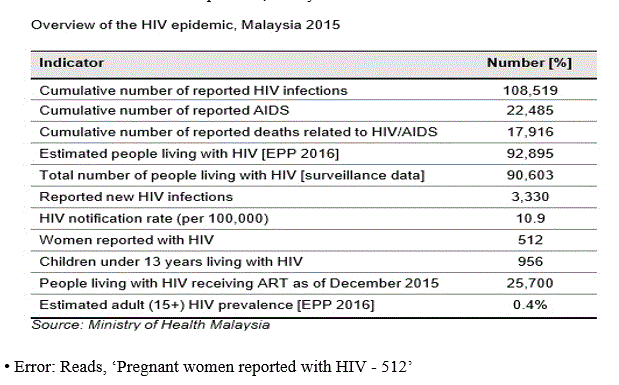
As found by the national surveillance-system, new HIV-infection declined by 50% between 2000 and 2015, and in the same time the number of HIV/AIDS-related death has stabilized.
Malaysia has made a significant progress in expanding its availability and accessibility in antiretroviral treatment from the time such became an integral-part of continued-care, treatment and prevention in 1990. By the end of 2015, about 25,700 PLHIV are found on life-saving antiretroviral therapy (ART). Women here preferably received ART (70%) compared to men (23%) [1].
Lubis et al (2013) [2,41] surveyed data of 845 HIV-positive patient from 1989–2009 and reported that factor ‘age 50 and older’, ‘secondary and tertiary education’ (compared with different education-levels), ‘unemployment’, ‘AIDS on presentation’, ‘single and double drug antiretroviral (ART) regime’, and ‘inability to achieve viral-load of not more than 50 copies/ml despite being on ART’ were significant predictors of death. Figure 1.
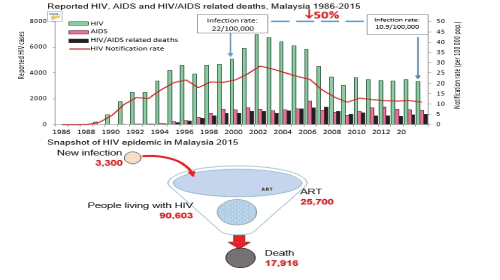
Source: Health Ministry, Malaysia
The country’s epidemic is seen very much driven by PWID early phase, but this pattern has changed to increasing sexual-transmission with PWID/sexual transmission ratio declining from 4 in 2000 to 0.2 in 2015. The bulk of the infection (75%) comprise of young-people aged 20 to 39, and children under 13 remain approximately 1% of HIV infections unchanged from 1986 through 2015 [1]. Figure 2,3. Table 2.
Table 2: Overview of Global AIDS Response Indicators.
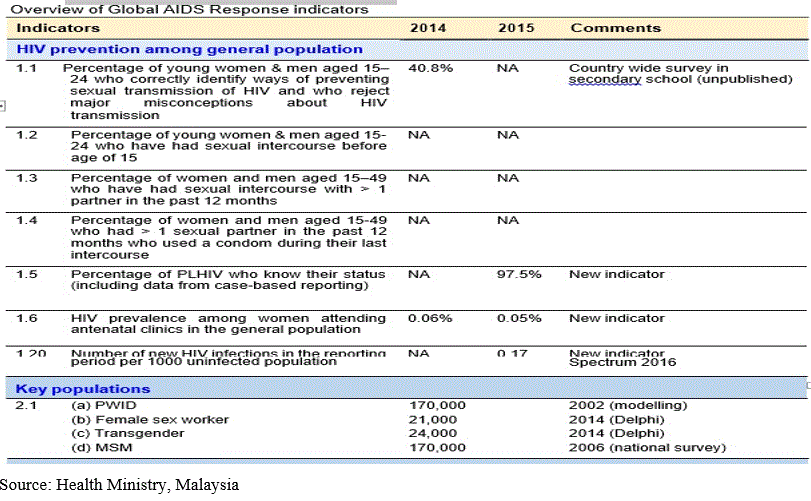
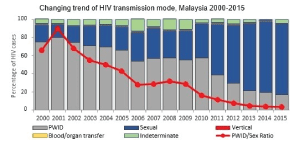
Source: Health Ministry, Malaysia
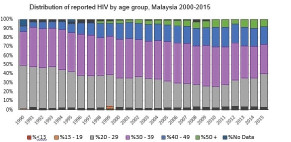
Source: Health Ministry, Malaysia
THE NATIONAL STRATEGIC PLAN (NSP 2010 – 2015) – THE COUNTRY’S RESPONSE
The NSP 2011-2015 is not implemented anymore and is now found changed by the new National Strategic Plan for Ending AIDS 2016-2030. Targeting across every priority programmatic-area, the previous NSP (2011- 2015) sought to prevent and reduce the risk and spread of HIV-infection, improve quality of life (QoL) of PLHIV, and reduce the social and economic impact resulting from HIV and AIDS on the person, family and society [1].
Many a target remain achieved in line with the Millennium Development Goal 6 (MDG 6) and the United Nation General Assembly Political Declaration on HIV/AIDS 2011, still found the significant area that need realignment and amendment aimed at closing the AIDS-chapter in this country, especially in the area of ART coverage and prevention-programme to the most-at-risk-population [1].
The five focus-area here are 1:
• Improving the quality and coverage of prevention-programmes among most-at-risk and vulnerable populations
• Improving the quality and coverage of testing and treatment
• Up-scaling access to care, support and social-impact mitigation-programmes aimed at People Living with HIV, and those affected
• Maintaining and improving an enabling-environment for HIV prevention, treatment, care and support
• Improving the quality of strategic-data through monitoring, evaluation and research
Improving the Quality and Coverage of Prevention-Programs Among Most-At- Risk and Vulnerable-Population
(a) Prevention of HIV transmission through sharing of needles and syringes
(b) Prevention of HIV transmission through unprotected sex – partnership with NGO
(c) Prevention from mother to child transmission of HIV (PMTCT)
Prevention of HIV transmission through sharing of needles and syringes
In October 2005, Malaysia launched a harm-reduction programme for the first time through the Opiate Substitution Therapy (OST), and in February 2006 the Needle Syringe Exchange Programme (NSEP) followed. OST is provided at both government and private health-facility, but NSEP is mainly provided at NGO-outreach location. Obvious progress is found seen with increasing number of site and client over the past few year. As at the end of 2015, both OST and NSEP reached at least 145,450 (85%) PWID out of estimated 170,000 PWID. Integrated Bio-Behavioral Survey (IBBS) 2012-2014 found a significant decline of HIV-prevalence among PWID [1]. Figure 4,5.
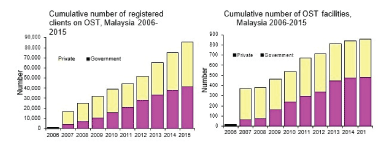
Source: Health Ministry, Malaysia

Source: Health Ministry, Malaysia
Prevention of HIV transmission through unprotected sex – partnership with NGO
In 2015, notification of HIV-infection by the PWID-route very much declined from 70-80% in 1990s to 16.8%, signaling a rise in sexual-transmission among the most-at-risk-population including FSW, MSM and TG [1].
Realizing the changing pattern of transmission from PWID to sexual, the NGOs through the Malaysian AIDS Council with the support from the Ministry of Health and Global Fund, scaled up the coverage of the targeted community-based programme (interventions) that include among the various, STI prevention-service, data, education and Behaviour Change Communication (BCC), referral to sexual-reproductive health (SRH) service, outreach and (peer-)education, promoting HIV-testing through voluntary testing and counselling [1].
Several articles highlighted the failure of the national drug-rehabilitation programmes, beside the punitive-response to the drug-problem in Malaysia and the successful launching and piloting of the harm-reduction policy and programme, including the drug-substitution therapy and needle and syringe exchange programme (NSEP) in 2005 [2,43-45]. Malaysia’s drug-policy, including attention on drug-abuse resulted in better access to HAART, reduction in HIV risk-behaviour and bigger social-benefit including increased-employment. [2,45] Sarnon et al (2011) [2,46] reported favourable reception of the NSEP among IDUs.
Wolfe et al (2010) [2,47] reported rather low access to ART among IDUs which is attributed to many a systemic and structural obstacle restricting treatment-access. The author did stress the need in integration of ART with opioid-substitution and TB-treatment, the need to increase peer-engagement in treatment-delivery and amend many a harmful-policy aimed at improving ART-coverage of IDUs.
In 2015, based on programmatic-data, a total of 7,784 client had been reached among the FSW, MSM and TG. IBBS 2014 indicated only 13.4% - 39.0% of most-at-risk-population (MARP) had received condom with guidance related to HIV. These go to prove that a substantial percentage of MARP have not been reached by prevention-programme and prevention-kit (condom and BCC), of quality, are found not adequately disseminated [1]. Figure 6.

Source: Health Ministry, Malaysia
Overall, safer sex-practices are found improved some among FSW and TG, but among MSM, condom-use behavior was not improving, proving the findings of Kanter et al above [1,11].
Teh et al (2008) [2,48] reported the HIV-problem as critical among the TG. Knowledge of HIV/AIDS was poor and the practice of safe-sex is found wanting. HIV/AIDS was not considered a primary problem among the TG. Finding employment and stigma against TG are found bigger and pressing issues. There is found no HIV-prevention activity in many a part of Malaysia toward TG need.
The IBBS survey in 2012 and 2014 found overlapping-risk among the most-at-risk-population with an alarming trend in alcohol and psychotropic-drugs used prior to sex. Such overlapping-risk very much impede the proper use of condom during sex [1]. Figure 7.
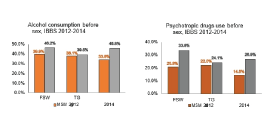
Source: Health Ministry, Malaysia
Prevention from mother to child transmission of HIV (PMTCT)
Following a pilot-project in 1997, the PMTCT-programme became the country’s key-programme when screening among the pregnant is found launched country-wide in 1998. Aiming at preventing vertical-transmission, all HIV-positive pregnant are given free ART and the HIV-exposed infants given ART prophylaxis. Aimed at further stopping vertical-transmission, the HIV-exposed infant is also given free replacement-feeding till two years of age. In around a decade, above 95% of the pregnant in Malaysia are found tested for HIV, with sero-conversion rate found at the average of 0.06% [1].
In 2015, around 99.4% (318) of the HIV-infected pregnant had received ART to prevent MTCT and 96.9% (251) of the HIV-exposed infant delivered are found given ART prophylaxis. As much as 95.8% of the infant delivered in 2015 had virology-test done within two months of birth. Through energetic activity found in a outline in the National Strategic Plan 2010-2015, the vertical-transmission rate has fallen to not more than 2% from 2011, and found the lowest rate at 0.77% in 2015 [1].
There is hope here now to achieve official-certification of the elimination of vertical transmission of HIV very soon [1]. Figure 8,9.
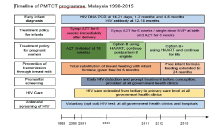
Source: Health Ministry, Malaysia
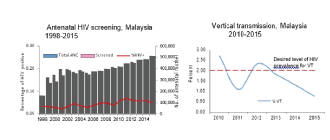
Source: Health Ministry, Malaysia
Aimed at promoting Primary Prevention of HIV, pre-marital HIV screening is found initially introduced by the Islamic Council in 2001 – starting in Johor-state and subsequently expanded to the different states country- wide; but the program had been limited to the Islamic pre-nuptial only. From 2009, this programme is available in the Government Health Clinic for all faith [1].
The programme is also aimed at teaching awareness to the mother-to-be and the spouse-to-be such that HIV-treatment could be started early in married-life prior to pregnancy. Over time, increasing numbers had been screened and the sero-conversion rate has been falling [1]. Figure 10.
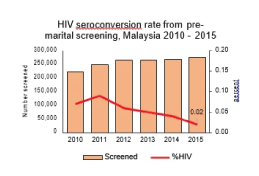
Source: Health Ministry, Malaysia
Improving The Quality and Coverage of Testing and Treatment
Malaysia has made a significant progress in expanding the availability and accessibility of antiretroviral (ART) treatment in the country beginning with free-monotherapy in 2001. A year subsequently in 2002, the government adopted a HAART policy with the following strategy [1,48].
(a) Provide free HAART to the patient with CD4 count <400
(b) Bring the price of the HIV-drug down through dialogue with the patent holder
(c) Encourage Malaysian-production of the HIV-drug that are not patented in Malaysia
(d) Seek here to opt to use of ‘Rights of Government’ under the Patents Act 1983 (i.e. the ‘Government Use’ option)
Through the initiative of Ministry of Health, Malaysia became the first country to issue compulsory license in 2003 [1].
By December 2015, about 25,700 (28%) PLHIV had been given ART. Aimed at improving HIV-screening and treatment, HIV-care is now found a integral part of the health-service provided at Primary Care, and with the aim to make health-care accessible, acceptable and affordable to the community, especially the Most-at-risk-population [1].
As at December 2015, around 90% (225) of Family Medicine Specialists country-wide have been trained in HIV-care and 50 mobile CD4 point-of-care testing have been located at Government Primary Care clinics [1]. Figure 11.

Source: Health Ministry, Malaysia
In aiming to complement and support ART-delivery, retention-in-care and adherence-to-treatment, the government in partnership with the Malaysian AIDS Council, introduced the Treatment Adherence Peer Support Programme (TAPS), aimed at critically enabling and ensuring treatment-literacy, adherence and outcome among MARPs. In 2015, TAPS had reached out to a total 5,397 client living with HIV in 32 treatment-centres, through 12 Partner Organizations [1].
In a effort to improve HIV testing and treatment, Voluntary Counseling and Testing (VCT) service became made part of the health-service provided at no cost in 1,039 Government Health-clinic and 141 Government-hospital. The use of the VCT-service increased around 3-fold from 2011; at a time that here the HIV sero-conversion fell in a gradient to the lowest at 0.19% in 2015. The Government through NGO recommends regular HIV-screening for most-at-risk-populations, but the use of this service in the recent time has remained not more than 50% (IBBS) [1].
In aiming to increase HIV-testing among most-at-risk-populations, the STI Friendly Clinic started in 2015 marked the new important milestone in improving the national response to the increase in sexual-transmission of HIV. Provided at the Government-clinic, this service has the aim to increase regular HIV and STI screenings amongst the most-at-risk-populations [1].
Up-Scaling Access to Care, Support and Social Impact Mitigation Programmes for People Living with Hiv and Those Affected.
In recent years, Malaysia saw impactful collaborative efforts between religious-organizations and various relevant government agencies, especially on matters in a concern of welfare, care and support for Islamic PLHIV.
In Selangor-state, the Islamic Council (MAIS) has included LGBT and sex-work as recipient of tithe (zakat) since 2011. A program came about aimed at creating awareness on principles of Islamic-teaching and self-enhancement apart from HIV awareness [1].
Kamarulzaman (2013) [2,49] had written on the needs of managing the HIV-epidemic in a multicultural and predominantly Islamic-Malaysia. The success in IDUs from implementing harm-reduction strategies to curb HIV-transmission was not seen in MSM and sex work [2,50]. Majority of MSM are in the married-category adding to the need to design appropriate (intervention) strategies in MSM. Wong et al [2,51] found that ethnicity is the strongest correlate in knowledge of HIV-transmission, self-stigma, and public-stigma attitude.
In terms of care and support-service, TAPS has proven good impact by tremendously increasing the number of PLHIV engaged at all levels of continued HIV-care from the time TAPS launched in the 2000s. Between 2012 and 2015, TAPS reached out to a total 12,940 PLHIV in 32 treatment-centres through 12 Partner Organizations. Money is allocate by the Health Ministry on a annual-basis for community-based organizations through the Malaysian AIDS Council for successful effort at TAPS [1].
Increasing treatment-adherence, improving health-condition, arranging employment and eventual reintegration of PLHIV in society are among the main strategies deployed by Care Homes operated by partner-organizations of the Malaysian AIDS Council. Between year 2012 and 2015, the partner-organizations operated 11 homes serving a total of 1,208 residents. A total 701 of these residents were PLHIV, out of whom 506 (72%) were on ART [1].
These homes are mainly financed by the Government (Ministry of Women, Family and Community Development) and through grants from various sources. The service provided by these homes include basic nursing-care, palliative-care, medical-referral, bereavement-counselling, and psychosocial and spiritual-support service [1].
In its attempt to build self-esteem and role-models among the residents, these shelter homes also offer opportunities for various life skills classes to assist as many residents as possible in developing skills-needs to establish independent living patterns, secure meaningful employment and function successfully in society. More importantly, these shelters enabled children and adolescents to stay in school, and assisted their transition to tertiary education ensuring self-sufficiency in the future. These shelters successfully conducted 332 training, 410 stakeholder meeting, 524 counselling and 1643 support sessions [1].
Mohd et al (2011) [2,52] surveyed children on ART aged 1-18 years and reported that almost all had not achieved the recommended energy-intake for the age-group and near 50% had vitamin A and selenium deficiencies. Nasir et al [2,53] reported lower body weight and low HDL-C but not so much selenium deficiency. The TREAT Asia (Therapeutics Research, Education, and AIDS Training in Asia, 2011) report [2,54] said 10% of Asian-children are on second-line ART. Better use of first-line regime and broader access to heat-stable, paediatric second-line and salvage formulation are in need. Early-diagnosis of treatment-failure is of little use, not unless the provider and the patient has access to appropriate medicine for children to change to.
Mendelsohn et al (2013) [2,55] compared and reported equal percentage between the refugee and the host-community client in terms of < 95% adherence and unsuppressed viral load reported. The refugee need be included in the HIV-strategies of the host country.
Hassan et al (2011) [2,56] reported that the common ART-agent used are lamivudine (64.6%), zidovudine (40.6%) and efavirenz (42.5%). Common adverse drug-reaction (ADRs) are fatigue, allergy, weight-loss, dry-mouth and memory-loss.
Hejazi et al (2010) [2,57] reported a high-prevalence of metabolic-abnormality, including raised level of serum triglyceride, LDL-C, total cholesterol and fasting plasma glucose-level.
Yagoub et al (2012) [2,58] explored the main-factor in adherence to HAART in a survey of 925 HIV-positive patient on HAART. Poor adherence is found (associated) with diarrhoea, vomiting, becoming forgetful, use of herbal-medications or religious treatment, beside the need to travel distance to seek medicine. Good adherence is found (associated) with the use of alarm-clock, acceptance of the HIV-status, older-age, better education, and bigger income. Effective treatment of adverse effect, persuading against alternative treatments, counselling, use of alarm-clock and easy access to HAART are in a need to improve adherence.
Foong et al [2,59] talked to healthcare-providers in two major HIV/AIDS-clinic in Malaysia and identified many a gap in providing care to the HIV-positive patient in primary-care setting. Such gap included lack of treatment and consultation-facility, lack of availability and accessibility to guidance/data, lack of publicity on available facility, lack of communication and team-working, beside the need in having effective coordinated-effort and clear-leadership.
Maintaining and Improving An Enabling Environment For Hiv Prevention, Treatment, Care And Support
It is essential to create HIV-knowledge and understanding that subsequently reduce risk-taking beside stigma and bias. Prevention and treatment programme is of added effectiveness when operated in an enabling-environment which do not stigmatize and is not biased against those most at risk, and those affected [1].
HIV is seen as an important concern in the country’s development-plan in which health-knowledge on HIV-prevention will here continue to be promoted with the cooperation of the Health Ministry and the NGO. The participation of the NGO / the CBO in the planning and deciding process has improved much. Civil-society is found represented at the National Coordinating Committee on AIDS Intervention (NCCAI) and the Country Coordinating Mechanism (CCM). In the previous, 32% of the committee-members (8 out of 25) are represented by civil-society representative (youth, women, MSM, PWID, sex work, PLHIV and transgender) [1].
Risk-behaviour among PWID in Malaysia is well-documented and such are not different from the findings of every such study conducted in many a different country [2, 6, 7, 13, 60-64]. In contrast, there is little or no data about connection (association) between the prevalence of HIV and risk behaviour in many of the marginalized-community in Malaysia such as sex-worker, MSM, TG, migrant-work and the refugee. Identifying risk-behaviour in such a group can help guide the design of risk-reduction strategy specific for each of such a group. The success of the opioid substitution therapy (OST) and needle and syringe exchange programme (NSEP) among the IDU are prime example of such a strategy targeted at identified risk-behaviour [2, 63-67]. Many a knowledge, attitude and practice study in Malaysia is found focussed on students, adolescents and pregnant women only. [2, 24, 25, 39-47, 68-72].
Enhanced surveillance of the disease is imperative – much of coordinated Active Surveillance activity is required in addition to Passive Surveillance.
Improving the Quality of Strategic Information Through Monitoring, Evaluation and Research
Malaysia’s surveillance system on HIV started in 1986. The surveillance system has moved ahead from manual-based notification to electronic-notification (e-notis) in 2001 and then a web-based National AIDS Registry became founded in 2009. Based on case reporting, in time the quality of data collection has improved tremendously.
With the founding of point-of-care testing of CD4 at primary care, this system is recently found improved to include expanded case-data on ART, co-infection and laboratory-result. The responsibility of HIV-surveillance is with the HIV/STI Sector of the Health Ministry. Aimed at supporting enabling-environment at work-area, the Code of Practice on Prevention and Management of HIV/AIDS at the Workplace was produced by the Human Resource Ministry as a guideline to both the employer and employee in managing matters pertaining to HIV at the work-area [1].
With the founding of the national Monitoring and Evaluation (M&E) unit within the HIV/STI Sector of the Health Ministry, HIV programme-monitoring is additionally systematic and comprehensive and include monitoring of programmes from the private-sector and the NGO. Analyses and use of M&E data has justified institutional-support from the Cabinet Committee on AIDS for improvement of many a programme [1].
Vulnerable and At-Risk Population
Most-At-Risk-Population
The HIV-epidemic in Malaysia is focused among the most-at-risk-population - PWID, FSW, MSM and TG [1].
Integrated Behaviour-based Survey (IBBS) is conducted at a regular-period among such most-at-risk-population (MARP) mainly to track behavioural and HIV-prevalence trend [1]. Table 3.
Table 3: Behavioural-trend among MARP, 2009-2014.


The Young Most-At-Risk-Population
The young population is vulnerable to HIV-exposure and transmission due to many a factor - mobility, living-situation (young people who live on the street), exploitation (young people who are sexually exploited and/or trafficked) and abuse. As defined by UNAIDS6, the young-population at bigger risk of HIV-exposure is anyone between the age of 10 and 24 years who is very likely to become exposed to HIV or transmit the disease. In general, parental-consent is required, in a strict manner, for the young (below 18) to receive HIV-testing [1].
From the last IBBS (2014), it is found that 47.8% MSM are among young people aged 18 – 24 compared with the PWID who are mostly older-adult aged 25 above. The National Surveillance Data captured all reported HIV-cases, whatever the age. The percentage of reported-PWID who are not yet 25 is stable at 3%, at a time when transmission through heterosexual-contact in those younger than 25 is reducing. In contrast, cases acquiring infection through homosexual/ bisexual contact among those < 25 is found increasing [1]. Table 4.
Table 4: Summary of MARPs.

Co-Infections
TB and HIV
Tuberculosis (TB) is the most common opportunistic infection in PLHIV worldwide. The risk of developing TB is estimated between 26 and 31 times greater in PLHIV than among those without HIV-infection [1].
As part of disease control and prevention measures, HIV-test for the TB (and STI) patient is offered by the health-provider here from 1997 – TB-screening among PLHIV begun in closed-setting from 2003. In 2010, isoniazid-prophylaxis became started aimed at reducing morbidity and mortality in TB/HIV co-infection. Opposite of the HIV-trend, TB-cases (incidence) in Malaysia is increasing annually, at a time when TB/HIV prevalence is scaling down from a peak of 10.3% in 2008 to 5.9% in 2015 [1].
Many a article published in the early 2000s report pattern of opportunistic-infections (OIs) in the Malaysian HIV-positive patient that are not different from research-finding from around the world. A retrospective survey of 419 patient in the Kuala Lumpur General Hospital (KLGH) from 1994–2001 found the dominant age-group to be 25–34. 53% had CD4 < 200 cells/mm3 at the time of diagnosis of OI. The study also here reported HIV-infection through IDU to be directly cor-related to the incidence of TB, and HIV-related TB is found dependently cor-related with unemployment. The four main AIDS-defining diseases are TB (48%), pneumocystis carinii pneumonia (PCP) (13%), toxoplasma encephalitis (TE) (11%) and cryptococcal meningitis (7%) [2,73].
Additional studies on pulmonary OIs in 406 AIDS patients in KLGH in 2001 found that most of them had CD4
Narwani et al (2004) [2,76] compared 97 HIV-negative and 97 HIV-positive among the TB-patient and reported differences between the two group in a concern of age, family-members to room ratio, sex and marital status. Mohammad et al [2,77] reported that HIV-positive TB patient is not so infectious to the contacts compared to the HIV-negative TB-patient.
Mohammad et al (2004) [2,78] found that 80% (117/149) had PTB and 20% had extra-pulmonary TB (ETB).
Velaiutham et al (2004) [2,79] found no cor-relation between Mantoux-testing, sputum-culture and CXR-severity in the HIV-positive TB-patient. The author also reported bigger incidence of sputum-smear negative, sputum-culture positive and non-reactive tuberculin skin-test in these patients. Tuberculous adenitis is found the most common ETB presentation.
Kooi et al (2001) [2,80] reported that the AIDS-patient with CD4 count < 200 cells/mm3 likely presents with atypical radiographic-appearance of PTB. Nissapatorn et al (2004) [2,81] reported that among the patient who defaulted therapy, a bigger percentage (87%) had PTB. No multidrug-resistant MDR-TB, or reactivated (relapsed) cases, is found in this study.
Ismail et al (2013) [2,82] in a survey among 219 of the HIV-TB patient, reported 53.4% had achieved successful outcomes (cure, completed therapy). Unsuccessful outcome (death, default therapy, treatment failure) is found (associated) with IDUs (OR 2.72), not being on HAART (OR 5.1), lymphadenopathy (OR 2.01) and poor nutritional-status (OR 4.61).
In a separate study among 227 of the HIV-TB patient, Ismail et al (2013) [2,83] reported 23.3% of them had died at the end of the study, out of which 40% died within 2 months of diagnosis. Survival at 2, 6, and 12 months after starting anti-TB therapy is 90.7%, 82.8% and 78.8%, respectively. Death is found associated with Malay ethnicity, CD4 count < 200 cells/mm3, presence of three or more OIs, not found on HAART and leucocytosis.
Toxoplasmosis
Shamilah et al [2,84] reported an overall prevalence of 26.3% with a (significantly) bigger prevalence in HIV-positive (31.3%) compared with the HIV-negative (24.3%) patient. But, Nissapatorn et al (2003) [2,85] reported toxoplasma IgG seroprevalence of 21% and 28.1% in the HIV- positive patient and HIV-negative blood donors, respectively. The CD4 count is not found associated with sero-positivity for toxoplasma antibodies in HIV/AIDS patients.
Nissapatorn in a new study (2009) [2,86] reported toxoplasma IgG sero-prevalence of 51.2% (208/416) in a survey of 406 of the HIV-infected patient and 14.9% are found diagnosed with active toxoplasma encephalitis (TE) while 10.6% are found with chronic (latent) toxoplasma infection. Significant association is found between CD4 count and TE (P = 0.019). The same, in a third study (2009) [2,87] reported a toxoplasma IgG sero-prevalence of 44.8% (226/505). Out of the 88.7% with no TE, 44.4% showed toxoplasma sero-positivity. In contrast, 11.3% (57/505) had TE, out of which 47.4% (27/57) showed toxoplasma sero-positivity.
A comprehensive review of toxoplasmosis in HIV/AIDS in 2009 reported the prevalence of latent toxoplasma infections in HIV-infected patients varied between 3–97% [2]. such as reported need to be studied further. The introduction of HAART resulted in marked decrease in overall incidence.
Parasitic infections
Asma et al (2011) [2,88] reported that a low CD4 count of < 200 cells/mm3 is associated with intestinal parasitic-infections (IPI). Lono et al [2,89] reported that HIV-positive individuals are three times at risk to acquire micro-sporidium infection compared to the HIV-negative individual (OR 3.2).
Fungal infections
A survey of 96 of the patient with cryptococcal infection from 2003– 2004 showed that HIV is the major contributing disease in 37.5% (36/96). Nor Hayati et al (2012) [2,90] reported that all cases were successfully treated with intravenous amphotericin B at induction and changed to itraconazole (80%) or fluconazole as maintenance (20%) with not any relapse.
Dermatological manifestations
Jing et al (2000) [2,91] reported a prevalence of muco-cutaneous disorders (MCD) of 71.4% (130/182). All had low CD4 cell counts and AIDS-defining illness. The commonly seen are generalised hyperpigmentation (35.7%), papular eruptions (29.1%), xerosis (27.5%), seborrhoeic dermatitis (19.2%) and psoriasis (7.7%). The commonest infection are oral candidiasis (35.7%), tinea corporis & onychomycosis (9.9%) and herpes (4.3%). Kaposi sarcoma is found rare. Rosnah et al (2000) [2,92] reported that the frequency of muco-cutaneous findings is proportionate to the severity of immune-depletion.
Progressive encephalopathy
Hamid et al (2008) [2,93] followed up 55 HIV-positive children and found the incidence of progressive encephalopathy is 18.2% (10/55). Low CD4 count and percentage are found associated with progressive encephalopathy.
Psychiatric disorder
Tung et al (2009) [2,94] reported a lower depression rate among the HIV-positive patient in Malaysia compared to the West. The patient dependent on family/friends for support, non-alcoholics and female-gender are found as significant predictors in depression. Psychiatric morbidity, including suicidality, was associated with CD4 count < 200 cells/mm3.
Muhammad Muhsin et al (2010) [2,95] found a very high prevalence of mental-disease and substance-use disorders, especially opioid dependence, in the HIV-positive prisoner. HIV infection is found significantly cor-related with age, ethnicity, marital status, history of IDU, lifetime-duration of incarceration, substance-abuse, poly-substance abuse and non-substance induced psychiatric disease. The prisoner with triple diagnosis (psychiatric disorders, substance use disorders and HIV) spent 46.7 cumulative-months in prison compared with those with only one psychiatric-diagnosis. HIV-infection and triple-diagnoses are not associated with violent offenses.
Hasanah et al (2011) [2,96] reported that the psychological and social health of the patient is additionally affected compared with the physical-health. Heterosexual-route of HIV-transmission is found associated with lower social-health, but not in IDUs. Figure 12.
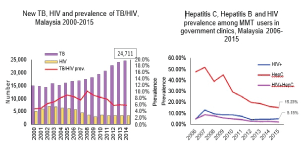
Source: Health Ministry, Malaysia
Hepatitis C, Tb and Hiv Infection Among Pwid
Screening of HIV, Hepatitis C and TB are routine-requirement for new-enrolment of Methadone Maintenance Therapy (MMT) client in the Government-clinics from the time of the launch of the Harm Reduction Programme in 2006. Programmatic-data indicate that Hepatitis C prevalence is found highest in 2007 (51.9%), but this rate has from that time declined to reach 15.2% in 2015. HIV-infection is also declining. This trend cor-relate well with the change in injecting-practice among PWID from the time clean needles and syringes became accessible starting 2006 [1].
Partnership Through Government And Non-Government Collaboration
The Health Ministry, through annual budget, has ear-marked in excess of RM 85 million (USD27 million) from the time 2003 toward programme in prevention and treatment and care and support among the MARPs in the country. This money is given out through the Malaysian AIDS Council to additional partner organizations to put in practice the high-impact prevention programme that include 1:
• Needle & Syringe Exchange Programme (NSEP)
• Methadone Maintenance Therapy (MMT)
• Prevention and treatment of HIV and various sexually transmitted infection (STI) among FSW, TG and MSM.
• Treatment Adherence Peer Support Programme
Stigma And Bias
HIV/AIDS-stigma is found around the world in a variety of manner, including ostracism, rejection, bias and avoidance of the HIV-infected. In 2014, Stigma Index assessment is found a part of IBBS. IBBS observed high amount of internalized-stigma among MARP in Malaysia, and most prominent among the PWID [1]. Figure 13.
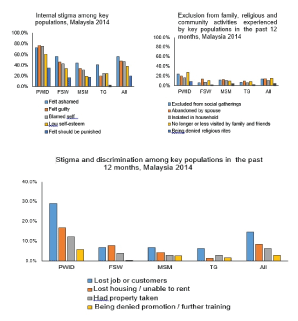
Source: Health Ministry, Malaysia
THE WAY FORWARD
Malaysia has achieved the Millennium Development Goal 6 target on HIV – reduction of new HIV-cases by 50%. But, there is still a huge gap in HIV-treatment, care and prevention-coverage among some MARPs. Such a gap and the problems to be surmounted continue as prime area of concern in the new strategic-plan to end AIDS by 2030. Among these are here 1:
a) Expansion of HIV-screening service beyond the traditional health-care system.
b) Accelerating treatment. The country need to find a innovative and a practical way to close the treatment-gap through introduction of ‘Treat ALL’ policy.
c) Reduce sexual-transmission of HIV among MARPs. Study has revealed that persistent condom use is still a big problem among MARPs and especially among MSM. Increase in substance and alcohol use prior to sex has added risk to transmission, and thus must be overcome.
d) There is still a big gap in TB/HIV care. A low-rate in early TB-screening and community-knowledge is observed to lead to late TB-diagnosis resulting in high-mortality among PLHIV due to TB.
Many a study has identified many a problem in the management of specific group of the patient with HIV/AIDS such as those with HIV-TB co-infection, IDU and the prisoner [2,97-109]. Many a outcome-study based on a strategy to set correct the discerned-problems must be carried out. The finding in such a outcome study is important in bringing around policy change. Further research is needed to scrutinize the problem of access to ART, particularly among the prisoner and the refugee. Research aimed at developing a strategy to improve adherence to ART, that is the key to success in managing HIV-infection, is needed to provide a picture around what is practicable and what’s not in the Malaysian-scenario.
Many a study on the use of post-exposure prophylaxis (PEP) against HIV beyond the use by healthcare-personnel is needed to bring around a policy-change to extend PEP to people who are exposed to HIV in a non-healthcare setting. PEP extended to such non-healthcare setting can be offered to the situation such as condom failure, victims of sexual-abuse and rape beside homosexual and bisexual men with multiple sex partners [2].
Further potential-area in research is the use of ART as a pre-exposure prophylaxis (PrEP) strategy, particularly in MSM, FSM and TG. Pre-exposure prophylaxis may prove to be a mainstay in controlling the transmission of HIV within such group and the general population, in the same manner as harm-reduction policies and programmes have done to control the HIV-epidemic among IDUs. The use of PrEP may be a reasonable option to sperm-washing and child-adoption in the non-conforming couple who aim to conceive still [2].
As the patient on ART could live further, research on the extended-duration effect of ART and additional causes of morbidity and mortality in such a patient need be conducted. The ADRs associated with older ART need be researched with the aim of making obtainable newer and safer drug. The outcome study on early treatment with ART and the brief-term and extended-term benefit of ART is required in widening the scope of coverage in the treatment of HIV [2].
The non-governmental organization (NGO) and the advocacy-group working with PLHIV must publish articles describing the work they did and the successes from such work, not only for the sake of success but also as the basis in finding important sources of money and support beside serving as guidance the various NGO and group could use [2].
More laboratory-based research need to be done especially in the areas of diagnostics - not excluding aim to predict, diagnose and manage the immune-reconstitution syndrome in the HIV-positive patient newly started on ART. Also, in a term of identifying potential drug-resistance based on viral-genotyping, molecular-surveillance and vaccine-development [2,110,111].
HIV diagnostic-testing has progressed from the time of the start in the early 1980s. The present enzyme-immunoassay is sensitive enough to detect antibody even early as one till two weeks after infection. A variety of different assay is required to confirm positive antibody-screens (Western blot, polymerase chain reaction [PCR]), and provide a adjunct to antibody-testing (p24 antigen, PCR), or provide additional data useful with the clinician treating the HIV-positive patient (qualitative and quantitative PCR, and genotyping) [112].
Most diagnostic-laboratory have complex testing-algorithm to ensure accuracy of result and optimal use of laboratory-resource. The assay to be picked is guided by the initial screening-result and the clinical-data provided by the physician - both are integral to the laboratory's ability to provide an accurate laboratory-diagnosis. The laboratory must also provide specific-data required on specimen-collection, storage and transport such that specimen-integrity is not compromised, hereby preserving the accuracy of the laboratory result [112].
Point-of-Care-tests have become increasingly popular in the United States and some such location in Canada over the past several year. These tests provide rapid, on-site HIV-results in a design that is quite easy for clinic-staff to do. But, these tests require adherence to good laboratory quality-control practices, and the backup of a licensed diagnostic-laboratory to provide confirmation beside resolution of the positive or indeterminate result. The laboratory quality-assurance program and participation in the HIV-proficiency testing-program is important to make certain that the diagnostic-laboratory provides a accurate, timely and clinically-relevant laboratory-result [112].
The Malaysian Clinical Practice Guideline (CPG) MANAGEMENT OF HIV INFECTION IN CHILDREN do recommend that every of the newborn-infant born require antigen-based investigation to definitively diagnose HIV in the young infant [113].
HIV DNA PCR, a sensitive technique used to detect specific HIV viral-sequences in integrated proviral HIV DNA in a patient's peripheral blood mononuclear cells (PBMCs) is also recommended. The sensitivity of a single HIV DNA PCR test performed at
The HIV RNA assay detects extracellular viral-RNA in the plasma and are as sensitive and specific as HIV DNA PCR in the early diagnosis of HIV-infection in the HIV-exposed infant. But, no HIV RNA PCR test is presently licensed in Malaysia for use in diagnosing infection [113].
The use of the presently-approved HIV p24 antigen assay is not recommended for infant-diagnosis in the reason of lower sensitivity compared to the various virology-tests. In general, HIV-1 DNA PCR assay is the preferred diagnostic test [113].
A Full Blood Count (FBC) need be carried out on the newborn as a baseline measure prior to the administration of zidovudine, and need be repeated at 6 weeks after completion of the zidovudine regimen [113].
At the time of birth, maternal-health data is reviewed to decide whether the infant is exposed to maternal co-infections such as tuberculosis, syphilis, toxoplasmosis, cytomegalovirus, Herpes simplex and Hepatitis B and C infections. Diagnostic-testing and treatment of the infant are based on the finding on the mother and infant. HIV DNA PCR test need be carried out at 14-21 day [113].
The Malaysian Clinical Practice Guideline (CPG) MANAGEMENT OF HIV INFECTION IN PREGNANT WOMEN recommend the best monitoring-tools such as plasma viral-load (HIV- RNA), CD4 count, â2-microglobulin and HIV-1 p24 antigen. Plasma viral-load is the best marker as it cor-relate quite well with disease-progression and predicts the risk of perinatal-transmission. Plasma viral-load need be monitored in the patient with HIV, especially those who receive HAART – and, the test need be done at 36 weeks gestation. The plasma viral-load at 36-weeks gestation is the best predictor of perinatal-transmission and this also can be used to decide the mode of delivery [114].
As HIV increases the risk of opportunistic infection, all patients with HIV should be screened for Hepatitis B & C, syphilis, gonorrhoea, toxoplasmosis and Chlamydia [114].
The National Strategic Plan for Ending Aids (NSPEA) 2016-2030
Launched in December 2015 in conjunction with World AIDS Day, this blueprint is found to outline the strategy to end AIDS in Malaysia. Developed through a diverse consultative process, the New National Strategic Plan for 2016-2030 adopts the “Ending AIDS” as the vision for Malaysia finding the country in the ‘Three Zeros: Zero new infections, Zero discrimination and Zero AIDS related deaths’. In the NSPEA, Malaysia is found to commit to Fast Tracking the HIV/AIDS response [1].
Malaysia is found to commit to “Ending AIDS” by 2030 through achieving the 95-95-95 target: 95% of MARPs tested for HIV and knowing the results, 95% of people infected with HIV placed on ART, and 95% of these adhering to treatment in suppressing viral load. The commitment does not exclude reaching 90% of the MARPs with effective prevention [1].
Given increasing numbers of patients, shortages of trained medical personnel, and financial constraints, there is a need to provide treatment and services for HIV/AIDS with added efficiency [115].
The Government and non-governmental organizations may build additional capacity toward prevention, treatment, and care of HIV/AIDS by making the most of the existing capacity. They could accomplish this by employing appropriate staffing-model to optimize impact and utilizing the capacity of the country’s institution(s) [115].
Every project made possible through partnership, including ‘twinning’ can fill a variety of the gap in current HIV/AIDS prevention, treatment, and care programmes. With respect to teaching, for example, partnership increase access to the faculty-expert where found in need. Partnership can also [115]:
• facilitate the introduction of new, effective technology used by the laboratory, informatic, logistic, communication, and teaching through training by the partner further familiar with these innovation;
• provide a consultation-network offering access to the expert-level technical-consultant in patient-care in such a area as clinical-care, pathology, radiography, and public-health;
• facilitate access to the relatively rare clinical-service, such as reference laboratory-support in anatomic or clinical pathology (e.g., pathologic diagnosis of complications of HIV/AIDS);
• enable electronic-sharing of curricula and library-resource;
• provide access to professional-development to improve the teaching-ability of the faculty;
• assist in developing the grant-management capacity to enable the institution to obtain support in operations-research and assessment;
• provide training in operations-research; and
• provide the resource to strengthen the entire health-system, not just the clinical-service.
The donor-country can play a role in building institutional and human-resource capacity to prepare for the protracted-term burden of HIV/AIDS by supporting every partnership at all level, beside the various capacity-building program [115].
It is important to do research to find an effective vaccine in the reason that [116]:
• The availability of a safe, effective and accessible preventive HIV-vaccine would be a valuable complement to the preventive-programmes, in the interruption of the chain of transmission of HIV.
• A well-conceived HIV-immunization-strategy could reach every population where the various (intervention) programme is not sufficiently effective.
• Research on the preventive HIV-vaccine is providing new data on a possible use of vaccine as a therapeutic-agent, to be used in association with ART, which could lead to reduction in the cost of treatment and to an increase in the protracted-term effectiveness.
From 1987, excess of 30 HIV candidate-vaccine have been tested in around 60 Phase I/II trials, using around 10,000 healthy-volunteers as subject. Most of these trials have been carried out in the United States and Europe, but several have also been carried out in the developing-country (Brazil, China, Cuba, Haiti, Kenya, Peru, Thailand, Trinidad, and Uganda). The results confirm the safety of the vaccines, and provide important scientific-data to develop the newer-generation candidate-vaccine with better ability to induce anti-HIV specific immune-response [116].
The first big trial of a HIV-vaccine reported results in 2003. The vaccine used in that trial, AIDSVAX, was designed to stimulate the production of antibodies against a region of an HIV surface-protein, gp120. The trial found that AIDSVAX was not any more effective than a placebo in preventing HIV infection [117].
A newer vaccine-approach had been tested in a big trial named STEP. This trial tested a vaccine designed to cause cellular-immune response. This vaccine used a adenovirus (Ad5) to deliver HIV-protein in a safe manner. The trial became halted in 2007 after an interim-analysis showed that the vaccine had not reduced the risk of infection. Further analysis found that people with the highest amount of antibodies to the adenovirus used in the vaccine had the highest risk of becoming infected with HIV after receiving the vaccine, at least during the early phase of the trial. This study show that care need to be taken in the choice of virus, or vector, used to deliver HIV-proteins in a vaccine [117].
A different study of a vaccine using the Ad5-vector but containing subtype B HIV proteins showed no effectiveness and a increase in the risk of HIV-infection in vaccinated-men after the study became un-blinded. It is still unclear why the risk of infection increased in such subject [117].
A newer-approach designed to induce both cellular-immunity and antibody-production has been tested in the RV144 trial. This study used two vaccines in what is called a ‘prime-boost’ approach. A vaccine called ALVAC-HIV had been used to ‘prime’ the cellular-immune system, using three sequences of HIV-proteins. The AIDSVAX vaccine had been used to boost the immune-response subsequently. ‘Prime-boost’ vaccines are designed to produce strong and protracted-lasting immune-response [117].
The RV144 trial showed that the prime-boost combination reduced the risk of infection by 31%. Many researchers became surprised by such a result as AIDSVAX had not protected against infection when used alone. A further surprising result is that the vaccine did not produce strong CD8 T-cell response in a majority of the participant and did not result in reduced viral-load in people who became infected despite vaccination. The vaccine did produce strong antibody-response to a region of the HIV-surface protein [117].
Further analysis showed that the specific antibody-response that also here brought around innate-cell immune-response (antibody-dependent cell-mediated cytotoxicity, ADCC) is strongly associated with a reduced-risk of infection in a vaccine-recipient. This finding persuaded researchers to test further prime-boost vaccine-strategy [117].
A version of the vaccine-combination used in the RV144-trial adapted for the type of HIV common in southern and eastern Africa (subtype C) had been tested in the HVTN 100 study. That study found the vaccine produced a very strong antibody-response of the type associated with protection against infection in the RV144-trial [117].
The present major vaccine studies are [117]:
The vaccine tested in the HVTN 100 study is now being tested in a much bigger trial in southern Africa. The HVTN 702 study (also known as Uhambo) has recruited 5407 people and will test whether the vaccine can reduce the risk of HIV-infection by at least 50%. The trial will also investigate whether a strong immune-response to HIV last in a protracted manner when using this vaccine compared to the RV144-trial, where the protective-effect of the vaccine began to wane after one year. The result of this study is expected in 2023.
A different prime-boost vaccine-approach is being tested in a different big study in southern Africa. This vaccine-approach has produced strong immune-response in animal-study and in preliminary human-study. The HVTN 705 study (also known as Imbokodo) uses a ‘prime’ vaccine consisting of a adenovirus-vector that deliver a ‘mosaic’ of HIV envelope and internal protein from four HIV-subtype designed to produce response against a wide range of HIV-subtype. The adenovirus used in this vaccine (Ad26) is not as common as the adenovirus used in the STEP study (Ad5) in the hope that pre-existing antibody will be not as common and will not interfere with the activity of the vaccine. The booster-vaccine used in this study has been shown to cause the production of antibody against the HIV envelope-protein, gp140. The Imbokodo study recruited 2637 women aged 18 to 35, the population at highest risk of acquiring HIV-infection in southern Africa. The result from this study is also expected in 2023.
Another study (the HVTN 706 trial) of the same mosaic vaccine-approach is expected to begin recruiting participants in North America, Latin America and Europe in 2019. This trial will use a prime and booster designed to produce response to subtype B HIV that is found to dominate in Europe and the Americas. The trial will not produce results prior to 2023.
A very different approach is presently tested in the AMP study. Rather than using a vaccine to produce broadly neutralizing-antibody, this study is testing the concept of giving an infusion of broadly neutralizing-antibody – Antibody-Mediated Prevention (AMP). The study will test how well the antibody protect against HIV-infection. If the method is successful, antibody-mediated prevention may provide the additional prevention-method until vaccine can be developed to bring around broadly-neutralizing antibody-response.
One study (HVTN 704) is testing a infusion of the broadly-neutralizing antibody VRC01 in 2700 MSM and TG in the US, Peru, Brazil and Switzerland. A different study, HVTN 703, is testing the same antibody in 1900 women in southern Africa. The result is expected in 2022.
It is widely expected that the first generation of HIV-vaccine will only be partially effective. Some will find only weak immune-response after vaccination. The RV144-vaccine reduced the risk of infection by only 31% but trial of newer vaccine are expecting reduction in the risk of infection by at least 50%, and preferably not less than 65%, to move forward. A vaccine which reduced even by 50% may nevertheless be very much cost-effective in the region of the world where the infection-rate is high and the cost of providing treatment will here continue to grow if the infection-rate cannot be reduced [117].
In the past thirty-year time, sentiments have swung from optimism to pessimism about the probability of producing a effective-vaccine. It is found optimistic again after the result of recent study [117].
Even if the big trial underway produce positive result after 2023, it will take several years yet till the result are analysed in full and submitted for regulatory-approval. Vaccine-manufacturing will need to be improved and money here need to be pledged by the donor to pay toward HIV-vaccination campaign in the lower-income country. Also, further study may be needed [117].
Having an effective vaccine is one need, but another major requirement will be to make certain that everyone who is at risk of HIV becomes vaccinated. Strategy must also become applied such that once a HIV-vaccine is fund, the delivery-system can be organized such that the vaccine can be made available without unnecessary delay to all people in need [117].
DISEASE-BURDEN AND FINANCIAL COST
In 2010, HIV/AIDS contributed to 2.8% of global death and 3.3% of total global burden of disease [118].
The Burden of Disease is found calculated in term of Disability Adjusted Life Years (DALY) by the methodology of the Global Burden of Disease Study - population and mortality data found provided by the Department of Statistics, Malaysia and the Notifiable Disease database, Health Ministry, Malaysia [118].
The total DALYs for HIV/AIDS for 2008 is 45,532 and it contributed to 1.6% of the total Burden of Disease in Malaysia. Almost 75% of the burden was due to YLL (mortality components). Males contributed 88% of the HIV/AIDS burden. The highest burden was among the age group of 30-44 (63.3%), followed by age group of 45-59 (16.6%). There is found a increase by 50% in the burden of HIV/AIDS in 2008 compared to 2000. Majority of the burden is due to associated mortality [118].
Is financial-cost an issue? Khairuddin L (2017) talked in a concern of cost:
Following diagnosis, anti-retroviral therapy (ART) is started when CD4 count hit ≤350 cells/mm3 (WHO recommendations) [119].
• Once on treatment, lifetime on treatment
• Non-adherence to treatment result in viral-load not suppressed - thus needing to change treatment-regimen
The Tables beneath here summarize the present cost of ART [119]: Table 5.
Table 5: Present Cost of ART, Malaysia.
First Line
| Combination | Name | Cost per month (RM) |
| 1 | Zidovudine+Lamivudine | 383.4 |
| 2 | Zidovudine+Lamivudine | 450 |
| 3 | Tenofovir Disoproxil Fumarate+Emtricitabine Edavirenz | 115.2 |
| 4 | Tenofovir Disoproxil Fumarate+Emtricitabine Nevirapine | 115.2 |
| 5 | Tenofovir Disoproxil Fumarate+Emtricitabine mtricitabine Efavirenz (single tab regime) | 115.2 |
Second Line
| Combination | Name | Cost per month (RM) |
| 1 | Zidovudine+Lamivudine Lopinavir + Ritonavir | 780 |
| 2 | Tenofovir Disoproxil Fumarate+Emtricitabine Lopinavir + Ritonavir | 115.2 |
Projection cost of lifetime ART
| Per month | Per Year | estimate lifetime* | |
| LOW | 115 | 1380 | 69,120 |
| MIDDLE | 417 | 5004 | 250,020 |
| HIGH | 780 | 9360 | 468,000 |
*All amount in RM, calculated as per person; lifetime estimated as 50 years (first diagnose and treatment around 20 years old with life expectancy as per general population, Malaysia male = 72 years old, female = 77 years old). Calculation does not include cost of CD4 + viral load lab tests, medication for additional co-morbidities beside consultation and/or hospital administrative fees.
Source: Khairuddin L., Penang Institute in KL, 2017
The aging-PLHIV present a definite cost-burden on the public health sector but Malaysia can afford to End AIDS – by having public money-source made available in a budget and found spent in the right-sector (i.e. treatment and prevention effort). Public-hospitals provide treatment for free - yet, treatment gap remain high, stigma hindering access [119].
The constraint is [119]:
• Issue here with adherence to treatment
• Most PLHIV have co-morbidity
• NGO find financing difficulty due to present economy; not much possibility of international sourcing due to Malaysia’s GDP found as upper middle-income country
• Cost of medication – trade-agreement and patent-law play a role
• Investing in End AIDS would reduce public health burden in the long run.
The Tables beneath here summarize the finances [119]: Table 6-9.
Table 6: Approximate Total Expenditure from Domestic (Public and Private) and International Sources by AIDS Spending-category, Malaysia 2013 – 2014.
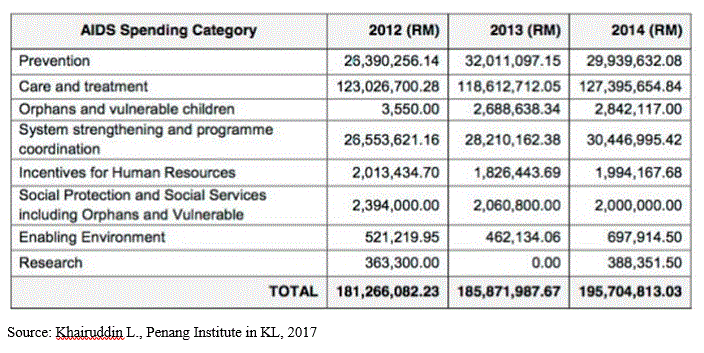
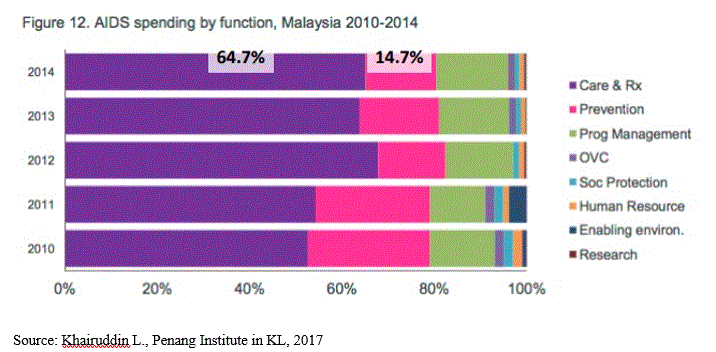
Table 7: Source of approximate AIDS expenditure, Malaysia 2012-2014.

Table 8: Total Annual Resource Need in ‘Ending AIDS’, Malaysia 2015-2050.
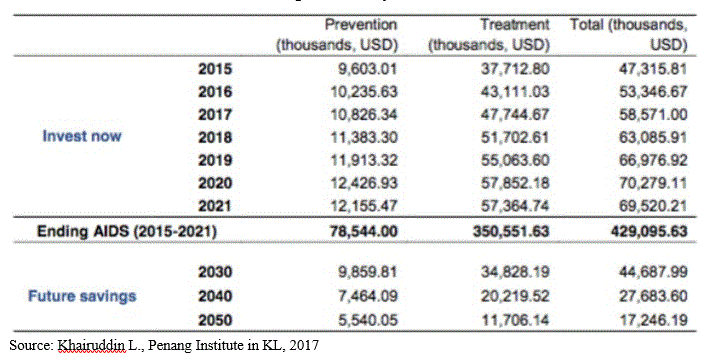
Table 9: Summary of Cost-effectiveness by Different Investment Option, Malaysia 2013 – 2021.
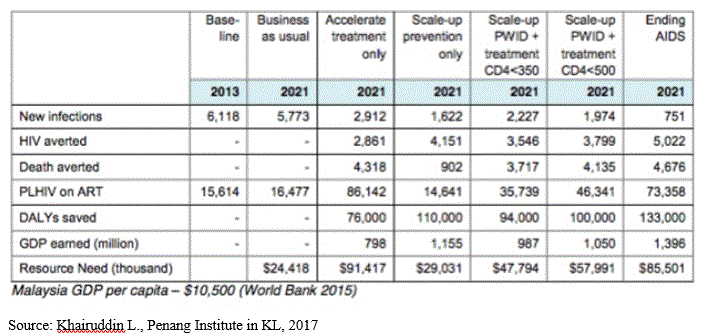
Conclusion
Malaysia has achieved the MDG6-target on HIV. But, there is still a huge-gap in HIV-treatment, care and prevention coverage. This gap is found to remain even as improved focus-area are found in the new strategic plan to end AIDS by 2030 [1,120].
HIV prevention programme can be successful only with full community and political commitment to bring around change and/or reduce risk-behaviour. Community health-education should include both broad-based campaign to increase knowledge of risk, transmission-mode and prevention-measure – and, targeted campaign with FSW, PWID, TG and MSM as the target. Effort at reducing stigmatization and bias must be included [121].
Correct and consistent use of male and female condoms is very effective [121].
Prevention of IDU and effective drug-dependence treatment, focused on OST and MMT is important. The NSEP, beside risk-reduction counselling, can effectively help [121].
Post-exposure prophylaxis can be useful in occupational exposure and after sexual-assault. Pre-exposure prophylaxis may be useful in prevention among MSM. Prophylaxis against opportunistic-infection among the HIV-infected is also relevant here [121].
All HIV-testing must follow the 5 C principles: consent, confidentiality, counselling, correct test-results and linkage to care. HIV-testing also provide a setting helping condom-distribution and delivery of prevention-message, beside personal-counselling. Requiring travelers from abroad to have HIV-testing/examination prior to entry is not necessary [121].
MTCT of HIV can be reduced primary prevention including prevention of unintended pregnancy in the HIV-infected, universal-screening of the pregnant, the use of maternal and infant ART and replacement-feeding where appropriate [121].
Strict anti-HIV-transmission measure and procedure must be followed in blood-donation and blood-transfusion activity, including HIV-testing. The high-risk donor must be excluded from donating blood, organ, tissue or cells, including semen in artificial-insemination [121].
Only medically required injection must be allowed. Caution in handling, using and disposing of the needle and the sharp-instrument is important. Medical-waste must be stored safe and destroyed. Health-work must be provided with latex-glove, necessary eye-protection and such personal-protection equipment, and instructed on the proper use. Universal precaution is necessary in the care of every patient, and in laboratory-setting. Effective use of germicide against HIV, M. tuberculosis and the many opportunistic-organisms is necessary [121].
Appropriate precaution is necessary in tattooing and skin-piercing activity, including equipment sterilization [121].
Attention must be given to the possibility of drug-resistance in ART and ADRs. ART should be harmonized across adults, children, adolescents and the pregnant. Infants must be excluded from BCG-vaccination. Concurrent OI must be managed in a appropriate manner [121].
Conflict of Interest
This author states here that there is found without any Conflict of Interest in writing this Article
References
- GLOBAL AIDS RESPONSE PROGRESS REPORT MALAYSIA 2016. Malaysia 2016 Country-responses to HIV/AIDS. HIV/STI Section, Disease Control Division Ministry of Health Malaysia. 2016
- Koh KC (2014) A Review of HIV/AIDS Research in Malaysia. Med J Malaysia 69 Suppl A: 68-81. [crossref]
- UNICEF. AIDS in Malaysia. http://www.unicef.org/malaysia/aids.html (accessed on 29 April 2014).
- Roshan TM, Rosline H, Ahmed SA, et al. (2009) Response rate of Malaysian blood donors with reactive screening test to transfusion medicine unit calls. Southeast Asian J Trop Med Public Health 40: 1315-1321.
- Tan HL, Koh KC (2008) Is HIV screening in the general population cost effective? Malaysian Family Physician. 3: 96-97.
- Chawarski MC, Mazlan M, Schottenfeld RS (2006) Heroin dependence and HIV infection in Malaysia. Drug Alcohol Depend 82 Suppl 1: S39-42. [crossref]
- Chawarski MC, Vicknasingam B, Mazlan M, Schottenfeld RS (2012) Lifetime ATS use and increased HIV risk among not-in-treatment opiate injectors in Malaysia. Drug Alcohol Depend 124: 177-180. [crossref]
- Dokubo EK, Kim AA, Le LV, Nadol PJ, Prybylski D, et al. (2013) HIV incidence in Asia: a review of available data and assessment of the epidemic. AIDS Rev 15: 67-76. [crossref]
- Vicknasingam B, Narayanan S, Navaratnam V (2009) The relative risk of HIV among IDUs not in treatment in Malaysia. AIDS Care 21: 984-991. [crossref]
- Juita G, Osman A (2006) Drug addiction and HIV infection amongst male in Malaysia, 1994. Jurnal Kesihatan Masyarakat 12(1).
- Kanter J, Koh C, Razali K, et al. (2011) Risk behaviour and HIV prevalence among men who have sex with men in a multiethnic society: a venue- based study in Kuala Lumpur, Malaysia. Int J STD AIDS 22: 30-37.
- Koh KC, Kamarulzaman A (2011) Profiles of men-who-have-sex-with-men seeking anonymous voluntary HIV counselling and testing at a community-based centre in Malaysia. Med J Malaysia 66: 491- 494.
- Dokubo EK, Kim AA, Le LV, Nadol PJ, Prybylski D, et al. (2013) HIV incidence in Asia: a review of available data and assessment of the epidemic. AIDS Rev 15: 67-76. [crossref]
- Balkis AK, Zahari CD (2003) HIV prevalence among antenatal mothers in Terengganu. Malaysian Journal of Public Health Medicine 3: 48-52.
- Japaraj RP, Sivalingam N (2001) The prevalence of HIV positive antenatal mothers in a routine screening programme in two states. Med J Malaysia 56: 180-185.
- Zahariyah Y, Rohani I, Shahrul Bariyah A, et al. (2003) A review of HIV antenatal screening programme in selected district in Kedah (1999- 2002). IMR Quarterly Bulletin (55): 39-43. (28).
- Lim SH, Guadamuz TE, Wei C, et al. (2012) Factors associated with unprotected receptive anal intercourse with internal ejaculation among men who have sex with men in a large internet sample from Asia. AIDS Behav 16: 1979-1987.
- Bachireddy C, Bazazi AR, Kavasery R, et al. (2011) Attitudes toward opioid substitution therapy and pre-incarceration HIV transmission behaviors among HIV-infected prisoners in Malaysia: implications for secondary prevention. Drug Alcohol Depend 116: 151-157.
- Gill JS, Norzuraida Z (2003) HIV risk behaviours among intravenous drug users. Malaysian Journal of Psychiatry 11: 18-23.
- Choi P, Kavasery R, Desai MM, Govindasamy S, Kamarulzaman A, et al. (2010) Prevalence and correlates of community re-entry challenges faced by HIV-infected male prisoners in Malaysia. Int J STD AIDS 21: 416-423. [crossref]
- Anonymous. STD prevalence among sex workers in Kuala Lumpur: Ministry of Health, Malaysia, 2001.
- Wickersham JA, Zahari MM, Azar MM, et al. (2013) Methadone dose at the time of release from prison significantly influences retention in treatment: Implications from a pilot study of HIV-infected prisoners transitioning to the community in Malaysia. Drug Alcohol Depend 132: 378-382.
- Fu JJ, Bazazi AR, Altice FL, et al. (2012) Absence of antiretroviral therapy and other risk factors for morbidity and mortality in Malaysian compulsory drug detention and rehabilitation centers. PLoS One 7: e44249.
- Akmal MN, Lee CK, Neng EE, et al. (2003) Women's attitudes to HIV screening in Hospital Muar antenatal clinic. Hospital Muar Medical Journal 1: 15-19.
- Sharifa Ezat WP, Mohammad J, Jamsiah M, et al. (2012) Knowledge, attitude and practice about HIV/AIDS and its influencing factors among pregnant mothers in west of Sabah, Malaysia. Malaysian Journal of Public Health Medicine 12: 15-23.
- Jasvindar K (2012) Knowledge of HIV transmission among Malaysians: a population based study. Journal of Health Management 10: 10- 19.
- Siti Norazah Z, Wong YL (2002) Knowledge, attitudes and beliefs related to HIV/AIDS among adolescents in Malaysia. Med J Malaysia 57: 3-23.
- Wong LP, Chin CK, Low WY, et al. (2008) HIV/AIDS-related knowledge among Malaysian young adults: findings from a nationwide survey. Medscape J Med 10: 148.
- Chew BH, Cheong AT (2013) Assessing HIV/AIDS knowledge and stigmatizing attitudes among medical students in Universiti Putra Malaysia. Med J Malaysia 68: 24-29. http://www.emjm.org/2013/v68n1/knowledge-on-HIV-AIDS.pdf
- Ibrahim N, Rampal L, Jamil Z, et al. (2012) Effectiveness of peer-led education on knowledge, attitude and risk behavior practices related to HIV among students at a Malaysian public university--a randomized controlled trial. Prev Med 55: 505-510.
- Jahanfar S, Lim AW, Loh MA, et al. (2008) Improvements of knowledge and perception towards HIV/AIDS among secondary school students after two hours talk. Med J Malaysia 63: 288-292.
- Jahanfar S, Lye MS, Rampal L (2009) A randomized controlled trial of peer- adult-led intervention on improvement of knowledge, attitudes and behavior of university students regarding HIV/AIDS in Malaysia. Singapore Med J 50: 173-180.
- Koh KC, Teh JR, Khan SA (2013) Beliefs and attitudes of medical students from public and private universities in Malaysia towards individuals with HIV/AIDS. Scientific World Journal 2013: 462826.
- Ni H, Htet A (2012) Knowledge and attitude of HIV/AIDS infection among medical students. International Journal of Collaborative Research on Internal Medicine & Public Health 4: 317-326.
- Rozina R, Lekhraj R, Lye MS, et al. (2009) Knowledge, attitude and practice related to HIV/AIDS among students in a local university (2007). Malaysian Journal of Medicine and Health Sciences 5: 27-41.
- Rozina R, Rampal L, Lye MS, et al. (2011) Factors influencing students’ attitude towards HIV/AIDS in a public university, Malaysia. Glob J Health Sci 3: 128-134.
- Fauziah MN, Anita S, Shaari N, et al. (2002) HIV infection among fishermen in Terengganu. Malaysian Journal of Public Health Medicine 2: 21-25.
- Anita S, Khatijah MY, Mahamin MY, et al. (2004) A cross-sectional study of knowledge, education, risk behaviour, attitude of HIV/AIDS among factory workers in three states. Malaysian Journal of Public Health Medicine 4: 40-46.
- Gulifeiya A, Rahmah M (2008) Nurses awareness and attitude towards HIV/AIDS and universal precautions: a cross-sectional study in UKMMC. Jurnal Kesihatan Masyarakat 14: 36-45.
- Hasnah B, Mohd Hatta M (2006) Knowledge, attitude and practice of prevention towards HIV/AIDS amongst health personnel in Tapah Hospital , Perak, 1996. Jurnal Kesihatan Masyarakat 12(1).
- Lubis R, Bulgiba A, Kamarulzaman A, Hairi NN, Dahlui M, et al. (2013) Predictors of death in Malaysian HIV-infected patients on anti-retroviral therapy. Prev Med 57 Suppl: S54-56. [crossref]
- Razali SM (2008) Drug substitution therapy: a new approach in preventing the spread of HIV/AIDS in Malaysia. Trop Doct 38: 109-110. [crossref]
- Reid G, Kamarulzaman A, Sran SK (2007) Malaysia and harm reduction: the challenges and responses. Int J Drug Policy 18: 136-140. [crossref]
- Kamarulzaman A (2009) Impact of HIV prevention programs on drug users in Malaysia. J Acquir Immune Defic Syndr 52 Suppl 1: S17-19. [crossref]
- Sarnon N, Baba I, Jusojf K, et al. (2011) Psychosocial reactions of injecting drug users' (IDU) towards needle syringe exchange program in Malaysia. World Applied Sciences Journal 12: 80-84.
- Wolfe D, Carrieri MP, Shepard D (2010) Treatment and care for injecting drug users with HIV infection: a review of barriers and ways forward. Lancet 376: 355-366. [crossref]
- Koon Teh Y (2008) HIV-related needs for safety among male-to-female transsexuals (mak nyah) in Malaysia. SAHARA J 5: 178-185. [crossref]
- Kamarulzaman A (2005) Taking stock of two decades of the HIV/AIDS epidemic in Malaysia. Med J Malaysia 60: 1-4. [crossref]
- Kamarulzaman A1 (2013) Fighting the HIV epidemic in the Islamic world. Lancet 381: 2058-2060. [crossref]
- Barmania S (2013) Malaysia makes progress against HIV, but challenges remain. Lancet 381: 2070-2071. [crossref]
- Wong LP (2013) Prevalence and factors associated with HIV/AIDS-related stigma and discriminatory attitudes: A cross-sectional nationwide study. Prev Med 57 Suppl: S60-63.
- Mohd NM, Yeo J, Huang MS, et al. (2011) Nutritional status of children living with HIV and receiving antiretroviral (ARV) medication in the Klang Valley, Malaysia. Malays J Nutr 17: 19-30.
- Nasir MTM, Yeo J, Huang MSL, et al. (2011) Nutritional status and the use of protease inhibitors among HIV-infected children in Klang Valley, Malaysia. Malaysian Journal of Medicine and Health Sciences 7: 73-79.
- TREAT Asia Paediatric HIV Observational Database (Typhoid), International Epidemiologic Databases to Evaluate AIDS (Idea) Southern Africa Paediatric Group. A bioregional survey and review of first-line treatment failure and second-line paediatric antiretroviral access and use in Asia and southern Africa. J Int AIDS Sock 2011; 14: 7-2652-14-7.
- Mendelsohn JB, Schilperoord M, Spiegel P, et al. Is forced migration a barrier to treatment success? Similar HIV treatment outcomes among refugees and a surrounding host community in Kuala Lumpur, Malaysia. AIDS Behav 2013. http://researchonline.lshtm.ac.uk/id/eprint/967532 (accessed 1 May 2014).
- Hasan SS, Keong SC, Choong CL, et al. (2011) Patient-reported adverse drug reactions and drug-drug interactions: a cross-sectional study on Malaysian HIV/AIDS patients. Med Princ Pract 20: 265-270.
- Hejazi N, Huang MSL, Khor GL, et al. (2010) Factors associated with abdominal obesity among HIV-infected adults on antiretroviral therapy in Malaysia. Glob J Health Sci 2: 20-31.
- Yagoub U, Awang B, Peramalah D, et al. (2012) Factors affecting adherence level to HAART (adherence predictors) in Kuala Lumpur, Malaysia. Life Science Journal 9: 3600-3603.
- Fong MY, Wong KT, Rohela M, et al. (2010) Unusual manifestation of cutaneous toxoplasmosis in a HIV-positive patient. Trop Biomed 27: 447- 450. (137).
- Fauziah MN, Anita S, Sha'ari BN, Rosli BI (2003) HIV-associated risk behaviour among drug users at drug rehabilitation centres. Med J Malaysia 58: 268-272. [crossref]
- Vicknasingam B, Narayanan S, Navaratnam V (2009) The relative risk of HIV among IDUs not in treatment in Malaysia. AIDS Care 21: 984-991. [crossref]
- Juita G, Osman A (2006) Drug addiction and HIV infection amongst male in Malaysia, 1994. Jurnal Kesihatan Masyarakat 12(1).
- Razali SM (2008) Drug substitution therapy: a new approach in preventing the spread of HIV/AIDS in Malaysia. Trop Doct 38: 109-110. [crossref]
- Reid G, Kamarulzaman A, Sran SK (2007) Malaysia and harm reduction: the challenges and responses. Int J Drug Policy 18: 136-140. [crossref]
- Kamarulzaman A (2009) Impact of HIV prevention programs on drug users in Malaysia. J Acquir Immune Defic Syndr 52: S17-19.
- Sarnon N, Baba I, Jusojf K, et al. (2011) Psychosocial reactions of injecting drug users' (IDU) towards needle syringe exchange program in Malaysia. World Applied Sciences Journal 12: 80-84.
- Degenhardt L, Mathers BM, Wirtz AL, et al. (2014) What has been achieved in HIV prevention, treatment and care for people who inject drugs, 2010- 2012? A review of the six highest burden countries. Int J Drug Policy 25: 53-60.
- Akmal MN, Lee CK, Neng EE, et al. (2003) Women's attitudes to HIV screening in Hospital Muar antenatal clinic. Hospital Muar Medical Journal 1: 15-19.
- Sharifa Ezat WP, Mohammad J, Jamsiah M, et al. (2012) Knowledge, attitude and practice about HIV/AIDS and its influencing factors among pregnant mothers in west of Sabah, Malaysia. Malaysian Journal of Public Health Medicine 12: 15-23.
- Vinothini A, Khoo EM, Adeeba K (2005) Knowledge of HIV/AIDS among pregnant women in an urban health clinic - a preliminary study. Family Physician 13: 10-15.
- Anonymous. Women and Girls. Confronting HIV and AIDS in Malaysia. Ministry of Health, Malaysia, 2008.
- Ahmed SI, Hassali MA, Aziz NA (2009) An assessment of the knowledge, attitudes, and risk perceptions of pharmacy students regarding HIV/AIDS. Am J Pharm Educ 73: 15.
- Nissapatorn V, Lee CKC, Khairul AA (2001) Impact of pulmonary opportunistic infections among AIDS patients in General Hospital Kuala Lumpur, Kuala Lumpur, 2001. Trop Biomed 18: 117-121.
- Anonymous. Consensus report on HIV and AIDS epidemiology in 2004: Malaysia, 2004.
- Jamalluddin AR (2003) Review of pulmonary tuberculosis patients with positive culture in Kuala Terengganu, 1998-2001. International Medical Journal (IIUM) 2(2).
- Narwani H, Naing NN (2004) Comparison of socio-economic and demographic characteristics of HIV and HIV-infected tuberculosis patients in Kota Bharu Hospital, Kelantan. Jurnal Kesihatan Masyarakat 10: 38-40.
- Mohammad Z, Naing NN, Salleh R, et al. (2002) A preliminary study of the influence of HIV infection in the transmission of tuberculosis. Southeast Asian J Trop Med Public Health 33: 92-98.
- Mohammad Z, Naing NN (2004) Characteristics of HIV-infected tuberculosis patients in Kota Bharu Hospital, Kelantan from 1998 to 2001. Southeast Asian J Trop Med Public Health 35: 140-143.
- Velaiutham S, Abdul Razak M, Khatijah B (2004) Characteristics of pulmonary tuberculosis in HIV seropositive patients in Chest Clinic, Penang Hospital. Malaysian Journal of Pharmaceutical Sciences 2: 31-31.
- Kooi ES, Mahayidin M (2001) Pulmonary Tuberculosis in HIV Infection : The Relationship of the Radiographic Appearance to CD4 T-Lymphocytes Count. Malays J Med Sci 8: 34-40.
- Nissapatorn V, Lee CK, Rohela M, et al. (2004) Spectrum of opportunistic infections among HIV-infected patients in Malaysia. Southeast Asian J Trop Med Public Health 35: 26-32.
- Ismail I, Bulgiba A (2013) Determinants of unsuccessful tuberculosis treatment outcomes in Malaysian HIV-infected patients. Prev Med 57 Suppl: S27-30. [crossref]
- Ismail I, Bulgiba A (2013) Predictors of death during tuberculosis treatment in TB/HIV co-infected patients in Malaysia. PLoS One 8: e73250. [crossref]
- Shamilah H, Lokman Hakim.S., Noor Azian MY, et al. (2001) Seroprevalence of Toxoplasma gondii antibodies in HIV positive and negative patients using the immunofluorescence antibody test (IFAT) methods. Trop Biomed 18: 137-141.
- Nissapatorn V, Lee CK, Khairul AA (2003) Seroprevalence of toxoplasmosis among AIDS patients in Hospital Kuala Lumpur, 2001. Singapore Med J 44: 194-196. [crossref]
- Nissapatorn V, Lee C, Quek KF, Leong CL, Mahmud R, et al. (2004) Toxoplasmosis in HIV/AIDS patients: a current situation. Jpn J Infect Dis 57: 160-165. [crossref]
- Nissapatorn V (2009) Toxoplasmosis in HIV/AIDS: a living legacy. Southeast Asian J Trop Med Public Health 40: 1158-1178. [crossref]
- Asma I, Johari S, Sim BL, Lim YA (2011) How common is intestinal parasitism in HIV-infected patients in Malaysia? Trop Biomed 28: 400-410. [crossref]
- Lono A, Kumar S, Chye TT (2011) Detection of microsporidia in local HIV-positive population in Malaysia. Trans R Soc Trop Med Hyg 105: 409-413. [crossref]
- Nor Hayati S, Sahlawati M, Suresh Kumar C, et al. (2012) A retrospective review on successful management of Penicillium marneffei infections in patients with advanced HIV in Hospital Sungai Buloh. Med J Malaysia 67: 66-70.
- Jing W (2000) A retrospective survey of mucocutaneous manifestations of HIV infection in Malaysia: analysis of 182 cases. J Dermatol 27: 225- 232.
- Rosnah T, Kamarul A, Mardziah A. (2000) Mucocutaneous manifestations of pediatric HIV/AIDS – their association with the 1994 revised CDC immunological classification and antiretroviral therapy. Malaysian Journal of Dermatology 13: 20-24.
- Hamid MZ, Aziz NA, Zulkifli ZS, Norlijah O, Azhar RK (2008) Clinical features and risk factors for HIV encephalopathy in children. Southeast Asian J Trop Med Public Health 39: 266-272. [crossref]
- Tung MY, Lee MHG, Ng CG, et al. (2009) Identifying depression among the human immunodeficiency virus (HIV) patients in University Malaya Medical Centre, Kuala Lumpur, Malaysia. ASEAN Journal of Psychiatry 10: 135-147.
- Muhammad Muhsin Z, Bae WH, Nor Zuraida Z, et al. (2010) Psychiatric and substance abuse comorbidity among HIV seropositive and HIV seronegative prisoners in Malaysia. Am J Drug Alcohol Abuse 36: 31-38.
- Hasanah CI, Zaliha AR, Mahiran M (2011) Factors influencing the quality of life in patients with HIV in Malaysia. Qual Life Res 20: 91-100. [crossref]
- Kamarulzaman A (2009) Impact of HIV prevention programs on drug users in Malaysia. J Acquir Immune Defic Syndr 52 Suppl 1: S17-19. [crossref]
- Sarnon N, Baba I, Jusojf K, et al. (2011) Psychosocial reactions of injecting drug users' (IDU) towards needle syringe exchange program in Malaysia. World Applied Sciences Journal 12: 80-84.
- Degenhardt L, Mathers BM, Wirtz AL, et al. (2014) What has been achieved in HIV prevention, treatment and care for people who inject drugs, 2010- 2012? A review of the six highest burden countries. Int J Drug Policy 25: 53-60.
- Mesquita F, Jacka D, Ricard D, Shaw G, Tieru H, et al. (2008) Accelerating harm reduction interventions to confront the HIV epidemic in the Western Pacific and Asia: the role of WHO (WPRO). Harm Reduct J 5: 26. [crossref]
- Wolfe D, Carrieri MP, Shepard D (2010) Treatment and care for injecting drug users with HIV infection: a review of barriers and ways forward. Lancet 376: 355-366. [crossref]
- Chou CC, Chronister J, Chou CH, et al. (2013) Responsibility attribution of HIV infection and coping among injection drug users in Malaysia. AIDS Care 25: 1551-1558.
- Suresh N, Balasingam V, Noor Zurani, Md Haris Robson (2011) The transition to harm reduction: understanding the role of non-governmental organisations in Malaysia. Int J Drug Policy 22: 311-317.
- Koh KC, Lee WY, Eh ZW, et al. (2013)Efavirenz does not cause false-positive urine cannabis test in HIV-infected patients on Highly Active Anti- Retroviral Therapy. Med J Malaysia 68: 249-252.
- Choi P, Kavasery R, Desai MM, Govindasamy S, Kamarulzaman A, et al. (2010) Prevalence and correlates of community re-entry challenges faced by HIV-infected male prisoners in Malaysia. Int J STD AIDS 21: 416-423.[crossref]
- Copenhaver MM, Tunku N, Ezeabogu I, et al. (2011) Adapting an Evidence- Based Intervention Targeting HIV-Infected Prisoners in Malaysia. AIDS Res Treat 2011: 131045.
- Wickersham JA, Zahari MM, Azar MM, et al. (2013) Methadone dose at the time of release from prison significantly influences retention in treatment: Implications from a pilot study of HIV-infected prisoners transitioning to the community in Malaysia. Drug Alcohol Depend 132: 378-382.
- Fu JJ, Bazazi AR, Altice FL, et al. (2012) Absence of antiretroviral therapy and other risk factors for morbidity and mortality in Malaysian compulsory drug detention and rehabilitation centers. PLoS One 7: e44249.
- Teh YK (2008) HIV-related needs for safety among male-to-female transsexuals (mak nyah) in Malaysia. SAHARA J 5: 178-185.
- Isa WY, Daud KM (2011) Distal renal tubular acidosis in HIV/AIDS patient. Intern Med 50: 1765-1768.[crossref]
- Lau KA, Wang B, Miranda-Saksena M, et al. (2010) Evidence for possible biological advantages of the newly emerging HIV-1 circulating recombinant form from Malaysia - CRF33_01B in comparison to its progenitors - CRF01_AE and subtype B. Curr HIV Res 8: 259- 271.(146).
- Fearon M1 (2005) The laboratory diagnosis of HIV infections. Can J Infect Dis Med Microbiol 16: 26-30.[crossref]
- CPG MALAYSIA. MANAGEMENT OF HIV INFECTION IN CHILDREN. MOH/P/PAK/158.08 (GU). February 2008.
- CPG MALAYSIA. MANAGEMENT OF HIV INFECTION IN PREGNANT WOMEN. MOH/P/PAK/156.08 (GU). February 2008.
- The National Academies of Science, Engineering and Medicine. Preparing for the Future of HIV/AIDS in Africa: A Shared Responsibility (2011): Chapter 5 -Strategies to Build Capacity for Prevention, Treatment, and Care of HIV/AIDS in Africa. The National Academies Press. 500 Fifth St., NW | Washington, DC 20001. 2018.
- Wharton M, Strikas RA, Harpaz R, Rotz LD, Schwartz B, et al. (2003) Recommendations for using smallpox vaccine in a pre-event vaccination program. Supplemental recommendations of the Advisory Committee on Immunization Practices (ACIP) and the Healthcare Infection Control Practices Advisory Committee (HICPAC). MMWR Recomm Rep 52: 1-16.[crossref]
- Alcorn K. The search for an HIV prevention vaccine. nam/aidsmap. July 2019. http://www.aidsmap.com/about-hiv/search-hiv-prevention-vaccine
- Azahadi O, Khoo YY, Shubash S, Fuad A, Siti Fatimah MH, Chandrika J. HIV and AIDS in Malaysia: How big is the burden in 2008?. Med J Malaysia. Vol 70 Supplement 1 September 2015
- Khairuddin L. Improving policies to mitigate HIV/AIDS in Malaysia. Penang Institute in KL. December 2017
- Meer Ahmad AM. The Control and Prevention of HIV/AIDS in Malaysia. 2nd International Conference on HIV/AIDS, STD & STIs. Meetings International. Amsterdam. March 2019.
- HIV Infection and AIDS in Control of Communicable Diseases Manual. 20th Edition. Heymann DL (Editor). APHA. 2015
